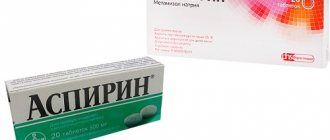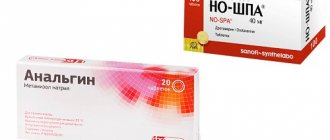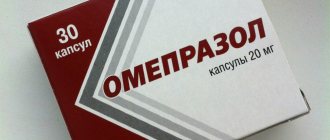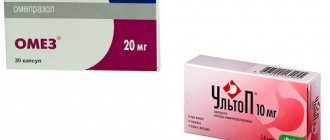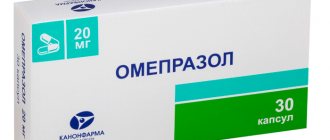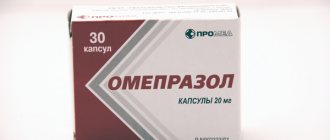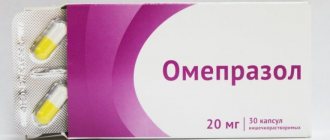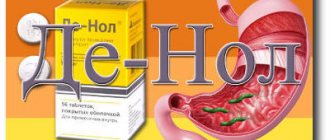Treatment of gastritis
For gastritis and stomach ulcers, you can take complex treatment.
The presence of symptoms such as nausea, vomiting, pain, and abdominal discomfort are clear manifestations of the presence of gastritis.
When treating chronic gastritis, every patient knows a huge number of medications that help eliminate symptoms.
You should not take medications when the first symptoms occur. You can undergo an examination and consult with a doctor, and only then undergo treatment and take various medications together.
Almost any disease of the gastrointestinal tract must be treated comprehensively. Today on the pharmaceutical market there are all kinds of drugs for gastrointestinal diseases. Depending on the symptoms, the doctor prescribes one or another medicine. The most popular among them remain Omez and De-Nol. But which of these two drugs is right for you, only a doctor can determine.
Can I take it at the same time?
Taking De-Nol and Omeprazole at the same time is often prescribed, since these drugs have different effects on the diseased organ. Moreover, doctors often prescribe taking the two named drugs along with antibiotics, and this is correct. This treatment regimen is used if the infectious nature of the disease is identified.
The compatibility of these drugs is beyond doubt; moreover, if you take Omeprazole and De-Nol together during one course of treatment, the drugs will enhance each other’s effects. When using drugs together, the following therapeutic effect is observed:
- Destroying the infection. Taking Omeprazole reduces the level of acidity, which, in turn, creates unfavorable conditions for the development of bacteria. De-Nol limits the mobility of pathogenic microorganisms, preventing their penetration into the walls of the stomach.
Advice! To more completely and effectively destroy the infection, antibiotics are prescribed simultaneously with Omeprazole and De-Nol.
- Additional protection and stimulation of regeneration. Omeprazole reduces the production of hydrochloric acid, which adversely affects the walls of the stomach, and De-Nol creates a protective film under which existing damage heals faster.
However, you need to know how to take De-Nol and Omeprazole together so that the drugs enhance rather than neutralize each other’s effects. The fact is that the protective film that forms when taking bismuth preparations prevents not only the introduction of bacteria, but also the action of drugs. Therefore, taking medications needs to be spaced out over time. As a rule, the following scheme is recommended:
- take Omeprazole in the morning on an empty stomach;
- after 30-40 you can drink De-Nol;
- in a quarter of an hour you can have breakfast.
But the doctor may recommend a different dosage regimen. For example, it is sometimes advised to take Omeprazole at night.
How to choose drugs depending on the acidity level
There are no medications in the world that can restore the functioning of the gastrointestinal tract in one go.
Moreover, they have side effects. You can only take pills with full confidence that they are intended for a specific disease.
When choosing medications, it is important to pay attention to the health of the liver, stomach, and duodenum.
This must be done because most drugs have side effects, and this can affect the health of internal organs.
This can be done with the help of doctors, thus it is possible to avoid aggravation of the situation and serious consequences.
Brief information about De-Nol
This drug also belongs to antiulcer drugs, but in addition it also has an antibacterial (used in the treatment of Helicobacter pylori) and gastroprotective effect (as a result of a chemical reaction, “De-Nol” forms a kind of protective film in the stomach on damaged areas of the mucosa.
A significant advantage of the drug is that it is practically not absorbed from the gastrointestinal tract and is excreted in the feces. A very small amount of the active substance enters the blood, which is later excreted through the kidneys.
Indications for use of "De-Nol" are:
- Exacerbation of chronic gastric and duodenal ulcers;
- Ulcer caused by H. pylori activity;
- Exacerbation of chronic gastritis and gastroduodenitis (including those caused by H. pylori);
- Irritable bowel syndrome;
- Non-ulcer dyspepsia;
Contraindications to taking De-Nol are intolerance to the substances included in the drug, pregnancy, and breastfeeding.
Omez and De-Nol for gastritis
The inflammatory process in the stomach, nausea and heartburn cause painful sensations.
Medicines can be prescribed for a single use to eliminate symptoms or taken in a course. De-Nol is recommended for use by a doctor.
Omez helps with stomach ulcers. It is a proton pump inhibitor. This medicine is based on Omeprazole. The drug is able to suppress the production of hydrochloric acid.
The combined use of Omez and De-Nol is included in many treatment regimens for diseases of the digestive system. They are used as basic drugs in the treatment of diseases of the gastrointestinal tract with different mechanisms of development.
One of the first symptoms of gastritis, an inflammatory process in the stomach, is pain. It is accompanied by belching and heartburn. Proton pump inhibitors and bismuth preparations are effective both when taken once and as a component of long-term therapy.
Their prescription for gastritis is due to the following features of the drugs:
Omez, by reducing the secretion of hydrochloric acid, reduces the damaging effect of the aggressive factor on the inflamed gastric mucosa.
De-Nol, like Omez, is an important component of anti-Helicobacter therapy, along with antibiotics. It is Helicobacter pylori, according to official studies, that is the key etiological factor in most cases of gastritis. Additionally, bismuth tripotassium dicitrate has an anti-inflammatory effect, protects the organ wall and stimulates rapid tissue restoration.
The combination of drugs provides a comprehensive effect on the pathogenesis of the disease. This helps to achieve stable long-term remission or recovery.
Carrying out eradication of the microorganism, eliminating aggressive factors, including high acidity, is a reliable way to treat hyperacid gastritis. In the presence of low acidity, taking Omez is not indicated. De-Nol can be included in the complex therapy of hypoacid gastritis.
Pharmacological properties
The main active ingredient of Omez is Omeprazole, which exhibits antiulcer properties. During the mechanism of action, this component inhibits the production of hydrochloric acid by blocking the work of the proton pump in the gastric glands. Daily intake of 20 mg of the drug normalizes the acid level of dietary juice for a day.
Colloidal bismuth subcitrate, the active component of De-Nol, helps form a film that protects the surface of the mucosa, which prevents the development of ulcerative and erosive lesions, protects against the effects of food juice and promotes scarring of existing lesions. The medicine reduces the activity of pepsins and pepsinogens, and also promotes the accumulation of epidermal growth factor in the problem area.
Quite often, doctors recommend using Omez simultaneously with De-Nol , especially in the presence of inflammatory processes in the stomach caused by the bacterium Helicobacter pylori, since both drugs work well to destroy it.
Omez. Indications for use
- Ulcers that arise due to stressful situations, improper use of medications. Omez is taken both during the remission stage and in the presence of an exacerbation.
- Gastritis.
- Eradication of the bacterium Helicobacter pylori.
You can drink the capsules whole, followed by 1 glass of still water.
You need to take the medicine correctly. It is forbidden to take Omez if you have an individual intolerance, children or pregnant women. Omez is an analogue of the Indian medicine called Omeprazole.
It helps reduce acidity levels and also helps protect the stomach from pathogenic bacteria. Ideal to take with De Nol.
Pharmacological action of Omez
- Quickly suppresses the production of excess HCl during the day and night, helping to eliminate dyspeptic symptoms.
- Maintains the pH of the stomach within a range favorable for the healing of peptic ulcers.
- Increases the activity of some antibacterial agents and has a bactericidal effect on Helicobacter pylori.
- Relieves pain in chronic pancreatitis by reducing the production of pancreatic enzymes and reducing pressure in the pancreas.
It is produced in the form of capsules and lyophilisate, from which an infusion solution is prepared. The medication does not provoke the development of acid rebound. The initial volume of production of the hydrochloric acid component of gastric juice is restored within a few days after stopping the medication.
Indications for use
- peptic ulcer of the stomach and duodenum;
- complex therapy for Helicobacter infection;
- gastritis;
- esophagitis;
- heartburn;
- gastroesophageal reflux;
- gastrointestinal erosions due to taking NSAIDs;
- ulcerogenic pancreatic adenoma;
- stomach maltoma.
Omez acts as a selective proton pump inhibitor.
Can be used as a prophylactic agent to prevent recurrence of ulcerative lesions.
The drug begins to act soon after administration, the hypoacid effect lasts up to 24 hours.
What is the difference between De-Nol and Omeprazole?
The pace of life in the modern world causes great damage to our health: snacking on the run, constant stress, smoking, regular consumption of alcoholic beverages. All this leads to the fact that each of the residents of megacities sooner or later ends up with a gastroenterologist with complaints of pain in the abdomen or stomach.
Often these symptoms indicate the presence of an ulcer, a disease that can be successfully treated with modern medicine, but which can be life-threatening if left untreated. Very often, after such a visit to the doctor, the patient receives a prescription for De-Nol or Omeprazole. What is the difference between these drugs? Let's try to answer this question below.
Brief information about Omeprazole
To begin comparing drugs, you must first get to know each of them.
Omeprazole is an active substance (which enters the active phase in the cells of the gastric mucosa), on the basis of which the drug of the same name is produced (this is what is discussed in this article), as well as many analogues.
The mechanism of action of omeprazole is as follows: it neutralizes excess acidity of gastric juice and also blocks the release of hydrochloric acid. As a result, favorable conditions are created for the regeneration of damaged areas of the mucosa.
Indications for the use of Omeprazole include:
- Peptic ulcer of the stomach, duodenum (Chronic form, stress ulcers that arose while taking anti-inflammatory drugs (NSAIDs));
- Reflux esophagitis;
- Zollinger-Ellion syndrome.
The effect of omeprazole begins approximately an hour after administration and continues for one day. After the patient completes the course of taking Omeprazole, the drug, due to its cumulative effect, continues to suppress the secretion of hydrochloric acid in the stomach for some time. As a rule, its effect finally ends on the fifth to seventh day after the end of treatment.
Due to the fact that the liver is actively involved in the process of removing omeprazole from the body, it is recommended that those who suffer from liver failure take the drug with caution.
Contraindications to taking Omeprazole are: hypersensitivity to any of the components of the drug, the patient’s childhood (up to 18 years), breastfeeding (in this case, the child is transferred to formula, it is allowed to continue feeding after treatment), pregnancy (in exceptional cases, it may decision to take it is made. But such a prescription always carries a risk, since there is no data on the safety of the drug for the baby).
Brief information about De-Nol
This drug also belongs to antiulcer drugs, but in addition it also has an antibacterial (used in the treatment of Helicobacter pylori) and gastroprotective effect (as a result of a chemical reaction, “De-Nol” forms a kind of protective film in the stomach on damaged areas of the mucosa.
A significant advantage of the drug is that it is practically not absorbed from the gastrointestinal tract and is excreted in the feces. A very small amount of the active substance enters the blood, which is later excreted through the kidneys.
Indications for use of "De-Nol" are:
- Exacerbation of chronic gastric and duodenal ulcers;
- Ulcer caused by H. pylori activity;
- Exacerbation of chronic gastritis and gastroduodenitis (including those caused by H. pylori);
- Irritable bowel syndrome;
- Non-ulcer dyspepsia;
Contraindications to taking De-Nol are intolerance to the substances included in the drug, pregnancy, and breastfeeding.
Comparison of Omeprazole and De-Nol
If you compare these two drugs, you can see that they are prescribed in almost the same cases.
However, the differences between them are quite significant. Let's compare medications according to all essential indicators:
Price and, which are currently on the market, are produced by Russian, Israeli and Serbian companies. The cost ranges between 30 and 150 rubles, depending on the dosage and package size. “De-Nol” is produced in the Netherlands, its cost is 500-1000 rubles per package.
pharmachologic effect
Omeprazole has an antiulcer effect and inhibits the proton pump. "De-Nol" has antibacterial, antiulcer and gastroprotective effects.
Active ingredient
The basis of the drug "De-Nol" is bismuth tripotassium dicitrate. Omeprazole uses the active ingredient of the same name.
Release form
"Omeprazole" is available in the form of hard capsules containing omeprazole 20 or 40 mg. "De-Nol" - in tablet form of a single dosage.
Contraindications
In this point, “Omeprazole” and “De-Nol” partly overlap: individual hypersensitivity to the components of the drug, pregnancy (“Omeprazole” can be prescribed in the second or third trimester, provided that the mother’s health is in serious danger.
In this case, the doctor may take a risk and prescribe Omeprazole, because although there is no official data on harm to the human fetus, animal studies have shown the teratogenic properties of the substance), breastfeeding.
The patient's age is not a contraindication to taking De-Nol, and Omeprazole is prohibited from being prescribed to children (with the exception of some medical indications for patients over 4 years of age).
Also, “De-Nol” should not be taken by persons with severe renal impairment, and “Omeprazole” is recommended to be taken with caution against the background of renal or liver failure (since these organs are actively involved in removing the substance from the body).
Interaction with other drugs
As a result of observations of patients taking Omeprazole daily, it was shown that taking the drug at a dosage of 20 mg/day does not affect the plasma concentration of almost all other drugs.
The only group of drugs with which it is not recommended to take Omeprazole are those whose work depends on the pH value. In this case, their effectiveness decreases.
As for the drug "De-Nol", when taking it, you should observe the time interval between food intake and medication. Half an hour before and after taking the pill, it is better not to eat, drink any other medicines, and also not drink milk or fruit juices, as they may reduce the effectiveness of the medicine.
Side effects
If you refer to the instructions for use of Omeprazole, then regardless of the country of origin, a fairly long list of side effects will be indicated there.
However, one should not panic, since most of these reactions were isolated cases that occurred against the background of serious illnesses.
At the same time, the manufacturer is required to include all recorded cases in the list of possible side effects.
We present here only those reactions that occur in less than 10% of cases: headache, bowel dysfunction, nausea, abdominal pain. All these symptoms are easily reversible, but if they occur, you should consult a doctor so that he can select an analogue.
"De-Nol" is rated by experts quite highly in terms of effectiveness and safety. However, occasionally, when taking it, the following reactions may occur:
- vomit;
- nausea;
- diarrhea or constipation;
- allergic skin rashes.
All these reactions pass quickly and do not require specific treatment. With prolonged intake of bismuth (the active ingredient of De-Nol) into the body, due to its accumulation in the central nervous system, the risk of developing encephalopathy increases.
In the end, I would like to say that De-Nol wins in many respects. But at the same time, its high price can scare off many buyers, especially those who suffer from chronic diseases and are forced to repeat courses of treatment regularly.
At the same time, “De-Nol” has a much wider spectrum of action; in addition to the healing effect, it also fights infectious agents and has an enveloping property. In any case, only the attending physician will be able to competently answer the question of which drug should be used in this particular case to achieve maximum effect.
Source: https://omeprinfo.ru/analogi/chem-otlichaetsya-de-nol-ot-omeprazola.html
De-Nol. Methods of use
It has an astringent effect and helps eliminate bacteria. This is especially true for the bacterium Helicobacter pylori. By reacting with hydrochloric acid, it creates a protective film.
Thanks to this film, the healing process of erosions on the wall of the stomach occurs, which is a good prevention of the development of ulcers and transformation into oncology.
Due to the decrease in pepsin levels, increased resistance to stress occurs.
De-Nol penetrates deep into the mucous membrane, helping to restore it and eliminate excess bacteria. Not absorbed into the gastrointestinal tract. It is excreted from the body through feces.
The drug acts as a selective proton pump inhibitor. The active component used here is omeprazole, a compound with the properties of weak bases, which is activated by acidic exposure in the stomach cavity. The drug irreversibly blocks the enzymatic activity of potassium-hydrogen ATPase, suppressing the final stage of hydrochloric acid production.
Restrictions on use
It is forbidden to take during pregnancy and lactation, in case of hypersensitivity. It is also not recommended for young children to drink.
It is strictly forbidden to use in chronic, advanced or acute stages of renal failure.
It is not recommended to use De-Nol in large quantities for the treatment of gastritis.
This is because the accumulation of bismuth in the body can lead to problems with the kidneys or central nervous system.
It is also important to maintain time and not take De-Nol 30 minutes before or after meals. The treatment regimen lasts for a maximum of 2 months.
De-Nol is made in the Netherlands. Significant differences in taking a medicine such as Omez from De-nol are in the effect on the main cause of the disease - the bacteria Helicobacter pylori.
Additionally, De-Nol creates a protective coating against damage to the gastric mucosa. It is better to consult a doctor before taking medications.
Indications for taking tablets
In almost one hundred percent of cases, the doctor prescribes a course of treatment with De-Nol for stomach ulcers and gastritis. However, these are not the only indications for taking this drug. The list of health problems that tablets can effectively treat is quite extensive:
- duodenal ulcer in different stages;
- gastroduodenitis;
- irritable bowel syndrome (including diarrhea as one of the symptoms);
- dyspepsia;
- peptic ulcer of the stomach;
- peptic ulcer of the duodenum;
- lesions of the gastric mucosa.
Most often, the last of these problems occurs with long-term use of non-steroidal anti-inflammatory drugs.
Release form of the drug
Before starting a course of treatment with De-Nol for gastritis or peptic ulcers, you need to protect yourself from counterfeits. To do this, you need to study what the tablets should look like.
The manufacturer produces the drug only in tablet form. They have a biconvex shape and are covered with a film shell. Usually the color of the tablets is close to light cream, but minor deviations towards darker or lighter shades are allowed.
The pills are very well protected from counterfeiting due to embossing. It is applied on both sides and consists of an inscription and a graphic design. Some patients treated with De-Nol complained of an unpleasant odor emanating from the tablets. Pharmacists note that this is the norm. Original tablets may emit a mild ammonia odor.
The manufacturer packages the drug in cardboard boxes. Each contains several blisters. They contain eight tablets. On average, a pack contains from seven to fourteen blisters. The maximum number of tablets in a package is one hundred and twelve.
Depending on the severity and nature of the disease, the doctor may prescribe both a minimum course of treatment with De-Nol and a maximum course with a possible repetition in a few months. Based on this, the patient has the opportunity to calculate in advance which package of tablets he will need.
Storage rules
Only a dry place, out of direct sunlight, is suitable for storing the drug; the room temperature should not exceed 25°C, otherwise the medicine may soon become unusable.
It is worth considering that storing it in a refrigerator or in a damp room can affect the loss of properties of the drug. It is best to keep De Nol in a special first aid kit, which will be kept out of the reach of children.
You need to pay attention to the appearance of the tablets. There should be no mechanical damage or punctures, otherwise it is better not to use such medicine. A change in color and odor may also indicate non-compliance with storage conditions, so such tablets are also not suitable for oral administration. In general, De Nol does not require special storage conditions. It is important to maintain temperature conditions.
Please note that the shelf life of the tablets is 48 months.
Directions for use and dosage
According to the instructions for use, the treatment regimen is as follows:
- For the treatment of children from 4 to 8 years of age, tablets are prescribed at the rate of 8 mg per 1 kg of the child’s body weight. The average therapeutic dosage should be divided into two doses during the day.
- If the child's age is from 8 to 12 years, the average dosage is 1 tablet twice a day.
- If the child has reached the age of 12 years or an adult patient is being treated, the drug is prescribed at the rate of 1 tablet 3 or 4 times a day.
- For gastritis with high acidity, you should take tablets 30 minutes before meals. De-Nol capsules are washed down with plenty of clean filtered or boiled water.
- The full therapeutic course for gastritis is 5 – 8 weeks. The final decision on how long De-nol should be taken is made by the attending physician. In some cases, a course is prescribed to prevent relapse of the disease.
- When the course of treatment with the drug is completed, it is not recommended to take medications containing bismuth for the next two months.
Instructions for use recommend taking the tablets 30 minutes before starting a meal. The patient takes three tablets before meals and the last tablet should be taken at night.
An alternative treatment regimen is to take 2 tablets before breakfast or before dinner. It is strictly forbidden to chew the tablets. It is possible to drink only non-carbonated clean water. Do not take the medicine with tea, milk or coffee. The action will reduce the effectiveness of treatment.
What is more effective: Omeprazole or De-Nol?
These drugs treat the same diseases, but belong to different pharmacological groups.
"De-Nol" is a gastroprotector (protects the mucous membrane from the negative effects of acids). The drug has a direct effect on the gastrointestinal mucosa. The medicine does not have a cumulative effect, but gives a positive result only during administration. If there are lesions on the gastric mucosa, this drug is always prescribed.
The main advantages of "De-Nol":
- – activates the growth and regeneration of tissues of the gastrointestinal mucosa;
- – heals and soothes ulcers;
- – relieves inflammation in the abdominal area;
- – eliminates excessive gas formation.
The drug is well tolerated and is considered safer than Omeprazole. Can be prescribed to pregnant and lactating women. Children under 4 years of age and older can be treated. The main disadvantage is that the drug is not available in injection form.
"Omeprazole" is an inhibitor. The drug is absorbed into the blood and blocks the functions of cells that produce acid. The medicine has a cumulative effect. After finishing the intake, the normal chemical composition of gastric juice remains for a long time.
The medicine creates the necessary conditions for proper secretion, treats the cause of pain, and not only relieves symptoms.
A tooth hurts, what to do at home to make the pain go away quickly, tablets for toothache, folk remedies
Omeprazole is prescribed for the following diseases:
- – gastroesophageal reflux disease (excess acid enters the esophagus);
- – lesions resulting from stress;
- – an ulcer that occurs after taking medications.
Omeprazole is not prescribed to children under 4 years of age. In the presence of liver dysfunction, the drug is prescribed with caution. Hypersensitivity to one of the components of the drug may occur.
The medicine works great as an ambulance. Omeprazole can be purchased in injection form. In the presence of advanced ulcerative lesions, the drug should be administered intravenously. The positive effect occurs as quickly as possible.
Comparison of drugs De-Nol and Omez
What is the difference between Omez and De-Nol? As already mentioned, these are drugs from different pharmacological groups. Omez is a proton pump inhibitor, that is, a drug that reduces the amount of hydrochloric acid in the stomach.
De-Nol is a restorative and antibacterial agent, that is, a gastroprotector. Therefore, it is difficult to compare these drugs, they act differently and can be prescribed at the same time.
pharmachologic effect
De-Nol has the following effects:
- gastroprotective;
- regenerating;
- bactericidal (active against Helicobacter).
Omez is an antacid, its pharmacological action:
- reduction of hydrochloric acid production;
- suppresses the growth of pathogenic microflora by creating negative living conditions for them.
Active ingredient
The active substance of De-Nol is a complex bismuth salt. This substance has a healing and regenerating effect. In addition, the product exhibits antibacterial activity against Helicobacter pylori infection. The active ingredient of Omez is omesoprazole or 5-methoxy benzimidazole. Antacid agent.
Since the active ingredients of the drugs are different, there is no risk of overdose when taken simultaneously.
Release form
The release forms of De-Nol are tablets. The drug is produced packaged in blisters of 8 pieces. One pack contains from 7 to 14 blisters. Omez is sold in capsule form; different forms contain 20 or 40 mg of the active substance. Capsules are packaged in blisters of 10 pieces. The package usually contains 2 blisters.
Indications for simultaneous use
Medicines are prescribed for the treatment of gastrointestinal pathologies accompanied by excess acidity. Indications for use:
- inflammation and erosive and ulcerative lesions of the gastric and duodenal mucosa;
- eradication of H. pylori (in combination with antibiotics);
- reflux esophagitis;
- dyspeptic disorders due to hyperacidity of gastric juice.
Often, a gastroenterologist prescribes taking De-Nol and Omez at the same time. These drugs belong to different pharmacological groups, their actions complement each other. How to take De-Nol with Omez?
It is very important to take these medications correctly, as taking them incorrectly can result in less effective treatment. Therefore, you should definitely check with your doctor about how to properly take De-Nol and Omez together.
The dosage of the drug is determined by the doctor, who must also recommend a treatment regimen. The standard treatment regimen with De-Nol and Omez is as follows:
- In the morning on an empty stomach you need to take an Omez capsule;
- after half an hour you need to take a De-Nol tablet;
- in another half hour you will be able to have breakfast;
- the second and third De-Nol tablets must be taken half an hour before lunch and dinner, respectively;
- The fourth De-Nol tablet is taken at night.
When a Helicobacter pylori infection is detected, antibiotics are included in the treatment regimen with Omez and De-Nol. As a rule, two antibacterial drugs are prescribed. The course of treatment with antibiotics is 7-10 days, it is necessary to take De-Nol and Omez longer, the course of treatment is 1-2 months.
The products are not intended for self-medication. They are used in consultation with a doctor, adhering to the prescribed dosages.
Description of the drug Omez
Omez is an analogue of the well-known drug Omesoprazole. The active ingredient is 5-methoxy benzimidazole. The drug has an effect on cells located in the gastric walls, reducing the production of hydrochloric acid and a number of enzymes. Thanks to this, the negative effect of aggressive substances on the walls of the stomach is reduced.
Advice! Taking antacid medications, including Omeza, can hide the symptoms of cancerous tumors in the stomach. Therefore, the drug should not be taken for self-medication; it is prescribed after a series of examinations.
The effect is observed within half an hour after administration and persists throughout the day, so you can take just one capsule of the drug per day.
Are there any differences
In fact, the main difference between the drugs is that they belong to different groups of drugs. The result is the same (elimination of disturbances in the structure of the gastrointestinal tract), but through different mechanisms.
You can ask your doctor (which is better to choose - Omez or De-Nol), but you are unlikely to get a definite answer: both medications have been successfully used for years in the treatment of gastritis and peptic ulcers and are good at eliminating them. Positive reviews from satisfied patients on online forums only confirm this.
Both drugs cause minor or moderate side effects (allergic reactions, diarrhea or constipation, effects on the central nervous system) that are reversible.
| "Omez" | "De-Nol" | |
| Use while driving a car | + | The effect of the drug on driving ability is unknown |
| Use in childhood | + | — |
| Use during pregnancy and breastfeeding | — | — |
| Maximum course duration | 8 weeks; may be longer in those with Zollinger-Ellison syndrome | 8 weeks |
Taking medications together
“De-Nol” and “Omez” are often prescribed together, but when many patients come to the pharmacy, they wonder whether the prescription is written correctly and how they take “De-Nol” and “Omez” at the same time. There is no need to worry, because these drugs are among the four pharmacologically active agents used in the treatment of chronic gastritis and ulcerative lesions.
They are written out in the standard scheme:
| Antiulcer drug | Proton pump inhibitor | Antibacterial agents | |
(according to doctor's testimony)
The effectiveness of the drugs increases significantly, and the treatment time, on the contrary, becomes longer. Therefore, taking “De-Nol” and “Omez” together is not only possible, but also necessary in case of serious disorders of the gastrointestinal tract.
Contraindications to De-nol and Omez
Medicines should not be taken if you are intolerant to their composition, have severe renal or hepatic dysfunction, or during pregnancy. Nursing mothers should interrupt natural feeding during therapy. This drug combination is used with caution for osteoporosis, anorexia, decreased gastric motility and a tendency to constipation. Age limit: 4 years.
Admission rules
When taking medications in one regimen, it is worth remembering the following nuances:
- Omeprazole is taken thirty minutes before the intended meal;
- The bismuth preparation should be consumed forty minutes after finishing the meal.
Differences in joint treatment of different groups of drugs. How to use “omez” for gastrointestinal pathology?
Overdose. How to determine it
When you start taking De-Nol, it is important to understand that an overdose is extremely dangerous. It causes irreversible changes in the body. Among them, acute renal failure can be distinguished, which in parallel leads to high slagging and increased blood pressure.
The most dangerous are brain dysfunctions. Initially, the patient feels only weakness, then insomnia is added to it. If the drug is not stopped, treatment can be fatal.
Disorders of the gastrointestinal tract, which have become chronic, are also one of the results of an overdose of De-Nol.
It is worth keeping in mind that an overdose of the drug occurs at levels such as one hundred milligrams of bismuth per liter of blood. This can only be determined in a laboratory way.
Patients need to know that there is no antidote to bismuth. Therefore, as an emergency aid in case of overdose, doctors use gastric lavage and adsorbents. In particularly severe cases, urgent hemodialysis is required.
Gastric diseases such as gastritis, ulcers, pulpitis are widespread among people of all ages. There are enough medications prescribed by doctors for exacerbations and for their prevention. Many of them can be used in complex treatment, so the question of which is better “Omez” or “De-Nol” often arises among patients.
De Nol - a medicine for the prevention of gastritis of the stomach
If a patient’s outpatient card contains a diagnosis indicating a pathology of the stomach, marked “chronic,” the gastroenterologist may recommend taking the drug during remission to prevent relapses.
During the season of exacerbations (autumn-spring), tablets can be prescribed together with omeprazole or pantoprazle in an individual dosage for a period of 14 to 28 days.
It should be noted that to avoid exacerbations, it is important not only to take medications, but also to follow a diet and diet. Do not drink alcohol, forget about smoking, fatty and smoked foods, spices, strong coffee and tea, chocolate, marinades. Maintain a physical activity regimen and avoid stress if possible.
Following these recommendations will allow you to keep the disease in remission, and in combination with the preventive use of De-Nol, you will completely forget about stomach problems.
Surely, patients suffering from ulcerative lesions of the mucous membranes of the digestive organs are familiar with such drugs as Omez and De-nol. Gastroenterologists recommend these drugs primarily because of their effectiveness and pronounced protective effect on the walls of the digestive organs.
There is often a situation when a doctor prescribes the simultaneous use of medications: let's figure out how to take Omez and De-Nol, which remedy is better and what to do when prescribed together.

